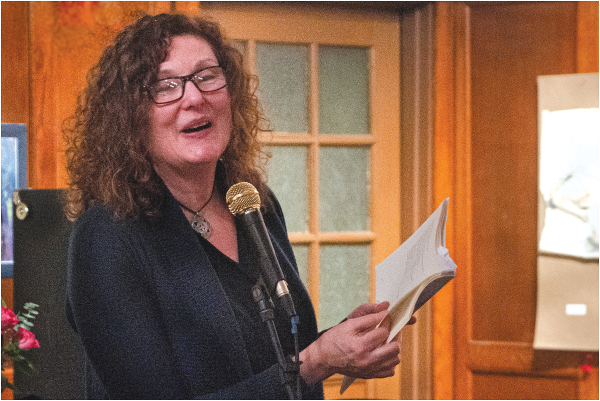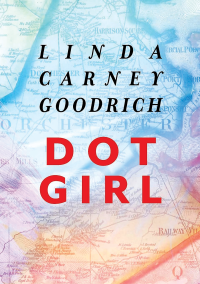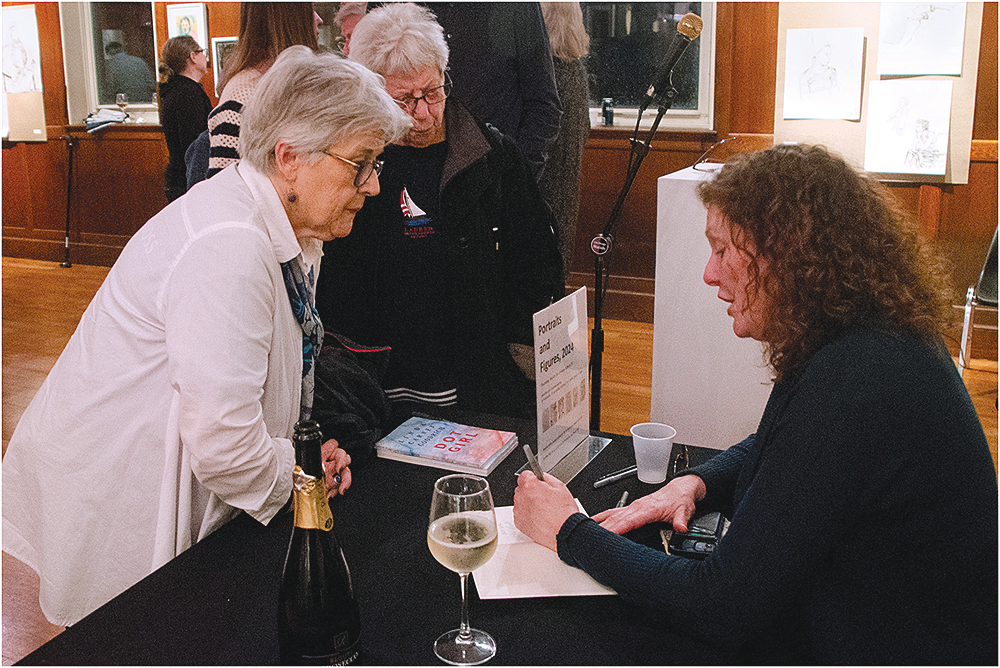April 4, 2024

Linda Carney-Goodrich discussed her newly-published collection of poems “Dot Girl” during a launch party at the Menino Arts Center in Hyde Park on March 23. The 55-year-old Dorchester native took her audience back almost half a century to her sometime-tumultuous childhood in Neponset.
Chris Lovett photo

Before she began reading from her debut collection of poetry, “Dot Girl,” Linda Carney-Goodrich shared an explainer about complex post-traumatic stress disorder.
Standing before about 50 people on hand March 23 for her launch party at the Menino Arts Center in Hyde Park, she said, “I do this in part because I want to use my personal story as sort of an extended metaphor, because I believe that unprocessed trauma lives in our bodies, but not just in individual bodies, but also in families and on streets and in neighborhoods and in towns and cities, and in countries and in our institutions – and that un-silencing ourselves is an important step in recovering.”
With the early selections from “Dot Girl,” the 55-year-old poet took her audience back almost half a century to her childhood in the Neponset section of Dorchester. It was a childhood sometimes roiled by family strife and abuse that led to Carney-Goodrich being placed in foster care. Added to that were conflicted memories of growing up Catholic in St. Ann’s Parish. But she could also find release, whether through a bike ride, a poetry program at the Murphy Community School, or the waters of Dorchester Bay.
The first poem in her collection, “Where the Water Meets the Sky,” is about the girl and her friends night swimming at Tenean Beach, before the waters were improved by the Boston Harbor cleanup. After sneaking out and dancing their way in silence, they reach the echo chamber under the Southeast Expressway at Conley Street, where they scream each other’s names, like “angry owls.” Rather than a cushion of sand on the beach, there’s something else afoot: “Tiny pieces of glass prick our feet reminding us of pain we haven’t felt.” The air is “foul and alive,” the water “bruised and murky,” the kids already exhaling memories and looking up:
“You claim there is a spot where the water meets the sky, Where souls swim free and no one calls them home.”
Carney-Goodrich spent even more time in the water at the Murphy School, where she was a member of the swim team. And this was around the time when a Dorchester woman who learned to swim at Tenean Beach, Karen Hartley, was making news for trying to go the distance across the English Channel. For Carney-Goodrich, the waters of the pool were enough to provide a refuge, a way for the body to hide, even “one of those lyrical things. And you’re also able to float, so you’re almost relieved of your body,” she recalled.
“I think for some people with trauma, or at least for me, it was a really great feeling of safety, and to feel like part of the water, and then to be good at it, and then to have to breathe rhythmically. You think about arm over arm – that’s bilateral. You have to do bilateral breathing, and you have to breathe deeply. And to swim lap after lap after lap, like many yards. You kind of have to go into a meditative state. And I think I did that.”
From the form and strokes of swimming, it was only a short distance to the rhythms of poetry, thanks to a teacher in another free program at the Murphy who exposed Carney-Goodrich to the writing of Langston Hughes. That also led to her first experience reading poetry aloud in public, at age 8, outside City Hall. The teacher also read a poem by her grandfather, and her mother bought her a dress for the occasion. It was a rare triumph shared by parent and child.
Carney-Goodrich was the ninth of ten children born at St. Margaret’s Hospital for Women in Dorchester. She remembers thinking of her parents as “scary figures,” but also being part of a time and place where women’s options were more limited and domestic violence was not uncommon. Despite the family strife and emotional hazards, she credited her mother with an appreciation of poetry and for insisting on attention to schoolwork. That helped her get into Boston Latin Academy and, years later, college and, eventually, to receive a master’s degree from Harvard School of Education.
Growing up also meant learning about power and status, even at close range. In “Uncle Hugh,” she picks up on the condescension of better-off relatives and relishes the sight of her father punching the dapper uncle with slick hair in the face (“We loved that we never had to see you see us again,” she writes). Even more smarting was eye contact with Pope John Paul II as his motorcade passed along Neponset Avenue in 1979, looking her way after a shout by her mother:
“He meets my stare, his eyes, sapphire knives cutting away all that isn’t mine.
I picture my family like ants crushed beneath his wheels.”
Carney-Goodrich would eventually marry and have three children of her own, along with developing her talent as a performance artist and a home-based educator. It was only about twelve years ago when she sharpened her focus on poetry through a program at at the Menino Arts Center (MAC) in Hyde Park, the neighborhood where she and her family live. She’s currently the center’s poetry coordinator.
The MAC program introduced Carney-Goodrich to Boston’s first poet laureate, the late Sam Cornish, which would later result in contact with his successors, Danielle Legros Georges and Porsha Olayiwola. Georges said she encountered Carney Goodrich by reading her poetry while judging submissions by local writers for display in City Hall.
“As someone who grew up in Boston, I was particularly interested in poems that conveyed a sense of what it means to live in Boston, poems that painted a picture of some aspect of life here, poems that were breathing life into the city of Boston. Linda’s poems were among them. She was writing what I’ll call Boston poems that at the same time were attuned to broad human questions, concerns, and desires,” Georges explained in an email response. “I was stopped by the strength and a certain positive rawness of her poetic voice.”
Carney-Goodrich would later receive a grant to participate in the intensive poetry workshop in Wellfleet, MA, led by Marge Piercy, a poet she began reading in the 1990s. Instead of juggling the roles of poet, parent, and educator, Carney-Goodrich could focus on writing.

Linda Carney Goodrich signed copies of her book of poetry, “Dot Girl,” in Hyde Park on March 23.
Chris Lovett photo
“So, having uninterrupted time to think and having a class with Marge every day, it was serious,” she said. “We were studying poems like the Beat Poets, and all these really old poems, and looking at line breaks. And it was such an amazing thing.” Carney-Goodrich was also encouraged to look at collections of poetry, and how separate works come together as a whole.
It was the “Uncle Hugh” poem that caught the attention of another Boston area poet, Anne Elezabeth Pluto, one of the founders and editors at Nixes Mate Review, whose Nixes Mate Books published “Dot Girl.” Carney-Goodrich also acknowledged help with finalizing her poems from another poet, Eileen Cleary. Introducing Carney-Goodrich at the launch party, Cleary told the audience, “The work of making a first book is arduous. It is this creative feat. And the reason it’s arduous is it’s done for the very first time.”
Some of the poems in “Dot Girl” are about how a child processes the mixed messages of Catholic teaching, with its shifting boundaries between literal, figurative, and contradictory. In the mid-1970s, just after the beginning of desegregation in Boston’s public schools, Carney-Goodrich was a seven-year-old kid, puzzled by signs with crosses in the neighborhood that said “Let’s SIN Together” (as in “Stay In Neponset”). Her mother explained the signs as meaning that Black families had to be kept out of the neighborhood. In her daughter’s mind, that triggered a connection between rumors of racial violence against Black families and a rudimentary concept of divine retribution.
In another poem, Carney-Goodrich is disturbed by having worn scapulars blessed by a priest at St. Ann’s who molested her brother. And there are the nuns at St. Ann’s, who insist that the wounds of Christ bleed forever in heaven.
In the poems, Carney-Goodrich’s mother can be either an ally or an antagonist, or a sum of unrealized potential, who never forgets having once been told that she could be a model. Carney-Goodrich explores the shape shifting in “My Mother’s Eyes Were Birds,” almost a catalogue of different bird’s-eyes for different moods. “I absorbed her calls and flight patterns,” Carney-Goodrich writes, even searching for eyes that she was told were hidden:
“I yearned to hold them in my hands, to wear them like gems,
to glimmer in her knowledge and wither in her stare.”
In the book’s later poems, post-traumatic stress is transformed into post-traumatic growth. The poet who started by addressing herself as a child addresses her father imagined as a teenager, before the years of rancor and boozy monologues in the kitchen. Though Carney-Goodrich never saw her mother after placement in foster care, there’s a poem in which she imagines being visited by a mother who sees her daughter turned into something else. In a dream “clear like salt,” she feels her mother’s bones pushing through her face:
“We dissolve into bruised and startling light We rise like moons
With each task I bring you with me
I say you are worthy of love or something close to it Your bones sigh in me We bruise like plums
eat pain delicious We call each other home.”
The last line could mean telling someone to come home, or it could also mean the mother and daughter, like birds of a feather, roosting in each other.
“I really meant that we call each other ‘home,’” said Carney-Goodrich. “I try to show in the book, I try very hard, to show the strength of the little girl who grew up in this situation. But I also try to show some kind of transformation, at least. There was never really reconciliation with me and my family, or my mother. My mother died without ever really seeing me again.”
Instead of a child’s notion of freedom, a distance from which no one is called home, there’s the closeness of a homecoming. The water at Tenean Beach –shallowed by mud rolls pushed out by the weight of the expressway – may be “bruised and murky,” but the imprint of a bruise – the emotional stigmata of pain –can be reimagined on a plum, succulent and bittersweet.
In another one of the later poems, the bruised and shamed body comes out of hiding, different parts singled out for praise, even the neck whose pivots enable a swimmer to breathe. At a town pool, the body is a mother in the water with her children. Exhaling, she shows them how the body can sink to the bottom, only to come up again for air.
Even the Catholic teaching about wounds that never heal resonates on the book’s dedication page with a quotation from the early 20th century Spanish poet Federico Garcia Lorca: “In trying to heal the wound that never heals, there lies the strangeness.” Lorca meant the struggle with darkness, the elusive quality of duende that made a poem extraordinary and original, with a purpose: to “baptize” those who behold it with “agua oscura” – another kind of murky water.
In her reading at the Menino Center, Carney-Goodrich wore a long forest green wool sweater. A seasoned stage presence, she punctuated her lines with moving arms and facial expressions, sometimes swept by ripples of long red hair.
The reading ended with the last poem in the book, “The Mothers of Dorchester Bay,” who “float and rise” above the water, immortal, with bodies unblemished and eyes “unblackened.” The voice here was stately, almost liturgical, even when the imagery was starkly mundane:
“Their dreams once tread upon shall be new and gleaming,
snapping like sheets in the wind, strung tight between triple-deckers.”
When it was over, Carney-Goodrich doffed her reading glasses. With her hair flung back, she looked drained yet renewed, like a swimmer reaching the surface.



